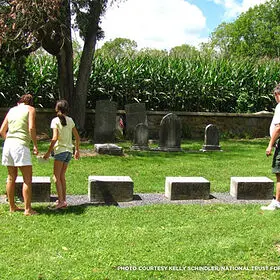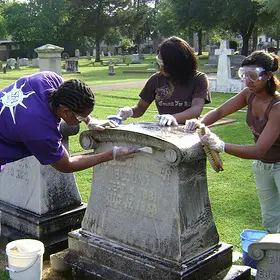On Memorial Day, Reflecting on African-American History

photo by: Nadia K. Orton
Every May, the nation marks Memorial Day, the longstanding tradition we use to recognize fallen veterans. The holiday has its origins in “Decoration Day,” originally held in Charleston, South Carolina in 1865, when thousands of former slaves, Union soldiers, and missionaries honored Union soldiers who had died in a Confederate prison and were subsequently buried in a makeshift mass grave.
Historian David Blight recounts that after the soldiers’ proper burials, a massive parade followed. Participants decorated the graves with flowers, and clergy delivered speeches to commemorate the fallen.
My personal introduction to Decoration Day began with oral histories provided by my family’s elders. In rural Tidewater, Virginia, they told stories of Decoration Day commemorations stretching back to the 1880s. Parades began in African-American communities and ended at local black cemeteries. Families and friends honored their ancestors through song and praise, while their graves were cleaned and re-decorated.
They had good reason to pay homage: Many veterans had returned from the front lines of war to become leaders in their communities, forming masonic lodges, burial societies, schools, churches, and cemeteries. These institutions formed the foundations of post-Civil War African-American communities, giving their communities potential for the very type growth and development African-Americans had been denied in slavery.
Preservation Tips & Tools: 10 Tips for Researching Historic Sites and Burial Grounds

This toolkit is designed to help you start researching cemeteries and burial grounds dating from the 17th to 19th centuries.
In most communities, the tradition was a mainstay through the aftermath of slavery, the promise and failures of Reconstruction, and the racial and economic destruction of Jim Crow. Decoration Day continued as many African-American cemeteries became overgrown and neglected, and the graves within were lost due to racialized vandalism, highway construction, and gentrification. Elders passed on, and some younger generations moved away. But the ancestors and their contributions were never forgotten by all.
Thinking on the true meaning of Decoration Day, I’ve found some of my veteran ancestors through a combination of oral history and genealogical research. I’ve discovered that some were thought lost and re-discovered, while others were truly lost to time.
I found the gravesite of my paternal third great-grandfather, Alexander Orton, who’d escaped slavery and served with the 10th U.S. Colored Infantry. Alexander had two elder brothers I’d never heard about, who’d also escaped a life of bondage: Charles and Daniel Orton, who enlisted with the Union Navy and the 1st Regiment, U.S. Colored Infantry, respectively.
After Charles enlisted in 1863, he was never heard from again. And Daniel Orton’s grave was never identified. He’d died on June 15, 1864, when a shell burst during the opening assault at the Siege of Petersburg, his comrades later testified. For nearly two months, his body lay in the field between enemy lines among hundreds of casualties until a flag of truce was called to bury the dead. It was a grisly, five-hour task, according to contemporary accounts.
Daniel likely rests in one of the thousands of “unknown” graves at Poplar Grove National Cemetery in Petersburg, Virginia. In 2015, at the National Archives in Washington, D.C., I located a letter that my third great-grandfather Alexander Orton wrote to his older brother Daniel, sometime during the war. Daniel never lived to receive it.

photo by: Nadia K. Orton
Letter from Alexander Orton, Co. E, 10th U.S. Colored Infantry, to Daniel Orton, Co. A, 1st U.S. Colored Infantry. Date unknown.
These discoveries helped me appreciate the collective sacrifice of over 180,000 former slaves and free African-Americans who enlisted in the Union to fight for freedom and equality. The pain of not being able to find Charles or Daniel Orton's graves inspired me to look to the burial sites of other U.S. Colored Troops. Over the years, I’ve documented many that were previously unknown. I’ve learned their stories, and how they came to serve their communities after the war.
The gravestones of some U.S. Colored Troops bear physical evidence of their local affiliations. The gravestone of Pvt. Thomas Fisher (ca. 1835-1894), of Co. G, 38th U.S. Colored Infantry rests in historic Greenwood Cemetery in North Carolina. He was a highly esteemed member of Zeredatha Lodge’s Free and Accepted Masons.
Military-issue gravestones from the Private’s era usually contain the soldier’s name, company, and regiment. Pvt. Fisher’s, however, includes the aforementioned information and three additional engravings: his date of death (December 2, 1894), “At Rest,” and the masonic symbol of the square and compass.
While Pvt. Fisher’s grave remains, others’ have been heavily vandalized or broken over the years. I’ve replaced a few, such as Pvt. Henry Brinkley’s grave, which was hit by a car, and Cpl. Edmond Riddick’s, which never included a headstone.
In other cases, I’ve helped descendants secure gravestones for their veteran ancestors and gained firsthand knowledge of previous Decoration Days from their family members. One descendant shared a story about the first African-American member of the New York Fire Department whose ancestor, John Hodges, was a landsman with the Union Navy.

photo by: Nadia K. Orton
The harsh reality of what these veterans fought for resonated through years of research. During the Civil War, it echoes in the narratives of the escape from slavery, to Union lines, to freedom. It’s witnessed in the collective acts of self-determination in the formation of community institutions, when segregation taught “separate and unequal.”
It’s in the statement of Sgt. John S.W. Eagles, who proclaimed to his men in the Grand Army of the Republic in 1884: “Why are over 50,000 colored soldiers laying beneath the sod today? Why are their bones bleaching in the dust tonight? For the privileges we are enjoying today. Civil rights, political rights, soldiers’ and sailors’ rights, and religious rights; and we propose to protect those rights, let come what will or may.”
The veterans that survived the war and returned home faced a climate of racial hostility and oppression, from the racial violence of the Ku Klux Klan and other white supremacist organizations, to segregation laws that flourished after the Hayes Compromise of 1877. Nearly all civil, social, and economic rights for which United States Colored Troops had fought and died were reversed between 1872 and 1900.
More generations of African-American veterans would face the same civil rights struggles as their Civil War-era predecessors. African-American soldiers fought for freedom abroad in ensuing decades, only to be continuously denied rights as American citizens at home. The “Double V” campaign of 1942, spearheaded by a leading African-American newspaper of the day, came to symbolize an ongoing struggle for civil rights that linked the fight against racism at home to the war against fascism abroad.
Preservation Tips & Tools: How to Preserve Historic Cemeteries and Burial Grounds

Cemeteries and burial grounds might not be as instantly lovable as grand architecture or beautiful historic sites, but they're an important and significant part of American life.
I reflected on this continuity while I was securing a replacement gravestone for Pvt. Zachariah Taylor (1846-1909), Co. H, 5th U.S. Colored Infantry. He rests near many of my paternal ancestors in the Mt. Calvary Cemetery Complex, a historically African-American cemetery in Portsmouth, Virginia. According to his military pension and death record, he was born in Hinds County, Mississippi. In 1864, he escaped slavery and enlisted with the 5th U.S. Colored Infantry in Virginia.
Researching Pvt. Taylor’s birthplace, I saw that Hinds County isn’t far from Decatur, Mississippi, which was the birthplace of World War II veteran Medgar Evers. Evers was assassinated in the fight for civil rights. Nearby, veteran James Meredith struggled to integrate “Ole Miss.”
At the core of my efforts to replace Pvt. Taylor’s gravestone was a poignant reminder on the historical inequities of preservation. Of all the known veterans in the Mt. Calvary Cemetery Complex where Pvt. Taylor rests, more than 60 percent fought in the Civil War. Only 46 percent of those veteran gravestones remain visible.
Over the years, my perspective on Decoration Day has changed. The planting of flags at the graves of U.S. Colored Troops has an added significance—something that wasn’t there before. My new awareness bears a certain weight. It is an acknowledgement of civil rights struggles born over a century ago, that themselves were a continuation of earlier struggles for the full equality of all citizens, regardless of heritage. A civil rights struggle that, though gaining progress, is a cause not yet won.
On Memorial Day, let us truly honor those that fought for freedom and social justice, and go forward in the preservation of their legacy.


